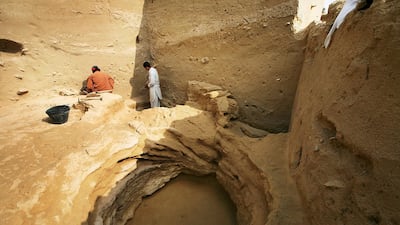Fossilised footprints of ancient elephants, copper mines from the neolithic era and a 7th century Christian monastery. These are some the archeological finds from across the UAE that have overhauled the way historians view the region's antiquity.
However, vast areas of land containing historical sites have yet to be excavated, some of which has already been located but is being left intact for the archaeologists of tomorrow.
“Archaeology has only been happening here for 62 years,” Peter Magee, director of the Zayed National Museum, said during a talk at the ongoing Abu Dhabi International Book Fair. “That’s not a lot of time. There is a lot of undiscovered material out there.”
As an archaeologist, Mr Magee says he knows of sites around the country that have yet to be unearthed. “We don’t excavate them,” he said. “Heritage has to be sustainable. We try not to excavate everything. We want the next generation of archaeologists to have something left, so they can do it.”
Another reason why contemporary archaeologists are hesitant to exhume discovered sites is because they predict better excavation technologies could be invented in the near future.
“On a large site, we might only excavate five or 10 per cent and leave the rest,” he said. “Get some information and then leave it. This is important.”
But just as importantly, Mr Magee said, is laying the educational framework to inspire and awe the next wave of archaeologists and museum specialists.
With historian Peter Hellyer as well as Mohammed Khalifa Al Mubarak, the chairman of Abu Dhabi's Department of Culture and Tourism, Mr Magee authored The Emirates: Our History.

The book, published in 2019, provides insights into the country’s geology, geography, politics and history, starting with its earliest inhabitants 125,000 years ago.
Covered in the book are the discoveries on Marawah Island, dating back more than 7,000 years, and the Bronze Age Umm Al-Nar culture and its extensive trade links, dating to around 2,600-2,000 BCE.
The book also explores the domestication of the camel, the invention of the Aflaj irrigation system as well as the development of the tribal and national entities.
The Emirates: Our History has become a staple in school curriculums across the UAE. It was distributed across public and private schools in 2019 along with a workbook, and training materials for teachers.
The goal was to instil in students a fascination in the country’s history. It is meant to hone an organised curiosity that teaches students how to think like historians and archaeologists, how to ask the right questions and test hypotheses.
“It was an honour,” Mr Magee said. “To have something that we wrote actually in school teaching the youth of today about their ancestors. To me, having written lots of scientific publications, this was the most important thing I wrote because it’s contacting people who’s story its telling.”

Mr Magee said that while books are instrumental in sparking an interest in history, students should also visit historical sites and museums in person.
“It’s key to learning, there’s something about visiting a site in Al Ain, for example, you can see the fabric of the building,” he said. “One of the things we are doing in the Department of Culture and Tourism – Abu Dhabi is that we are very keen on activating archeological sites for the public.”
The sites, Mr Magee said, should not be presented in a way that makes them mysterious. “Our job is to explain them, make them friendly in a way,” he said.
A few years ago, Mr Magee was tasked with making the 1,400-year-old Christian monastery in Bani Yas more accessible to the public. The site was fitted with a shade so that it could be visited during the hotter months of the year and tracks were paved around it.

“But also it’s the signage,” he said. “It’s the way in which you describe what’s found on the site. To communicate to a seven or eight year old what was discovered on the site so that they can become more excited.”
Mr Magee said he hoped the Zayed National Museum, expected to open sometime later this year, sparks a similar sense of excitement in its younger audience. He pointed museum’s architecture, designed like falcon’s wings, is built in a way to create air circulation. The wings of the museum create a thermodynamic wind movement that cools the gallery space. The technology is reminiscent of the one applied to traditional wind towers.
“When students come to the museum, when they read about how it employs this movement of air and see how the technology is in their own cultural DNA, I want them to be amazed and proud.”
Amazement and curiosity, he said, is what would encourage students to return to museums and historical sites. “I want them to still be thinking about them the next day, so that they have a question and that question will drive a return visit. A fantastic outcome would be for a seven year-old to leave a site or museum and say ‘I want to be an archaeologist’ or ‘I want to be a museum director’. That would be a great outcome.”


